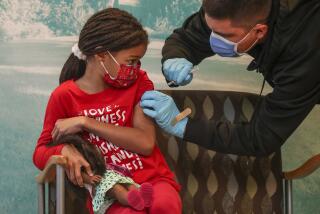HEALTH / PEDIATRIC RESEARCH : Children’s Drug Trials Come of Age Amid AIDS Epidemic
- Share via
WASHINGTON — The AIDS epidemic has created a quiet revolution in the way experimental drugs and life-threatening diseases are studied in children.
“The tradition until recently has been to ‘protect’ children from experimental therapy,” said Dr. Philip Pizzo, chief of pediatrics at the National Cancer Institute. “The general requirement was that one must complete Phase 1 (safety) testing in adults before beginning with children. When AIDS came along, it required a change of philosophy.”
Early in 1986, for example, when findings were beginning to emerge about the impact of the antiviral drug AZT on adults suffering from AIDS, Pizzo said, “we began negotiating with Burroughs Wellcome (the drug’s manufacturer) to begin Phase 1 testing in children. It took most of the year.”
In contrast, he said, studies are now begun in children “either simultaneously or within a month” of starting the same studies in adults.
“I think this is a very good thing,” said Dr. Robert T. Schooley, an AIDS specialist who heads the infectious diseases division of the University of Colorado Health Sciences Center in Denver.
“Pediatric research has often been based on the premise that children are so different from adults that you have to slavishly repeat everything that’s been done on adults in children several years (later). Investigators have bent so far backwards to safeguard the potential well-being of children that innovative drugs were often held up for years before being given to kids.”
Dr. Sam Broder, director of the National Cancer Institute, agreed.
“The whole momentum of the field has moved into the recognition that, where you have a lethal disease and a child is suffering and there are no conventional therapeutic options, you really have to start talking about the early implementation of experimental therapy,” he said.
Broder and others noted that there has never been an argument against the early testing of drugs in children for diseases that are specific to childhood. Further, Broder said, cancer research has for many years emphasized the need to study drugs in children as early as possible.
Nevertheless, many acknowledged that, for many years, the prevailing attitude overall was one of strong resistance to including children in studies of experimental drugs. There were numerous reasons for this, they say, among them liability and ethical concerns, particularly questions about providing adequate informed consent.
Although the situation in recent years has changed dramatically for drugs for lethal diseases, many say that there is reluctance to use children in tests of drugs for conditions that are not immediately life-threatening.
“The situation we have faced for 25 years--and still face--is that somewhere between 60% to 80% of drugs are not labeled for use in children” because they have never been studied in children, said Dr. Ralph Kauffman, professor of pediatrics at Wayne State University School of Medicine in Detroit.
Dr. Robert Temple, director of the Food and Drug Administration’s office of drug evaluation I, agreed.
“Once you leave cancer and AIDS, most drugs don’t save lives,” he said. “There are kids with very high cholesterol. What do you do with them? There are kids with hypertension. If people are reluctant to put adults with hypertension in a placebo-controlled trial, they’re going to be twice as reluctant with children.”
However, the latter situation is less likely to experience the kinds of changes that are occurring for AIDS and other critical diseases because the risk/benefit equation is considerably different. In the meantime, there has been virtually no debate over the acceleration that has occurred within the framework of AIDS.
“Never have people come to us and said they were concerned about getting experimental therapy,” Pizzo said. “If anything, they were concerned about not getting it. You want to get what you can to save your child.”






